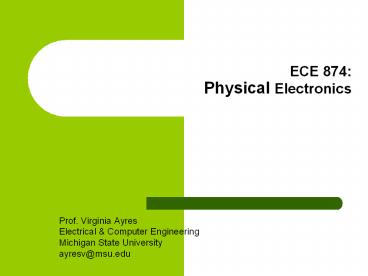ECE 874: Physical Electronics PowerPoint PPT Presentation
Title: ECE 874: Physical Electronics
1
ECE 874Physical Electronics
- Prof. Virginia Ayres
- Electrical Computer Engineering
- Michigan State University
- ayresv_at_msu.edu
2
Lecture 04, 11 Sep 12
3
Example problem the surface of a Si wafer is a
(001) plane. Which, if any lt110gt directions are
perpendicular to the Si wafer (001) plane
direction?
4
(No Transcript)
5
110
6
110
Battery -
Principles of Electronic Devices, Streetman and
Bannerjee
7
Convenient to know two directions
Crystalline direction lying within the surface plane (transport directions) Primary flat gives a lt110gt direction
Surface orientation 111 or 001 also gives n or p type Secondary flat
8
(No Transcript)
9
Primary flat is a reference direction to help you
find any in-plane transport direction that you
want
Note that the directions are different for (1110
and (100) type orientations
110
10
Example problem
11
Example problem
12
Example problem
13
(No Transcript)
14
(No Transcript)
15
(No Transcript)
16
(a) 8 lt111gt type directions to the 8 facets
however Angles to top facets are all the same
values. Angles to bottom facets are all the same
values.
001
111
17
(No Transcript)
18
(No Transcript)
19
(b) 4 pieces 4 top cleavage planes split open at
the pressure point
001
20
(c) Now locate facet w.r.t in plane direction
001
111
110
21
(No Transcript)
22
More about non-Si crystal structureswurtzite
and rock salt
23
Motivation to study what crystal structures can
do
From The Economist 01-07 Sep 12 Technology
Quarterly Very recent recognition chalcogenides
have well-controlled crystalline versus amorphous
crystal structures as a function of pulsed
thermal energy. Very local 10 nm 1/0 states and
very low energy needed to switch between them.
It looks like chalcogenides are going to be the
next hot thing for flash drives with a lot of
capacity. From Wikipedia chalcogneides can
be Cadmium telluride Indium sulfide Zinc
telluride Sodium selenide Other
mixes Crystalline phase zinc blende, (Id check
wurtzite too)
24
Recall the diamond crystal structure is formed
from two interpenetrating fcc lattices displaced
(¼, ¼, ¼)
25
with only 4 of the atoms from the
interpenetrating fcc inside a single cubic Unit
cell.
26
Wurtzite is formed from two interpenetrating
hexagonal close packed hcp lattices of different
atoms
3 S
7 Cd
7 S
3 Cd
3 S
7 Cd
27
Wurtzite is formed from two interpenetrating
hexagonal close packed hcp lattices of different
atoms, inside a hexagonal Unit cell
hcp lattice 01
Note tetrahedral bonding inside
28
Wurtzite is formed from two interpenetrating
hexagonal close packed hcp lattices of different
atoms, inside a hexagonal Unit cell
hcp lattice 02
Note tetrahedral bonding inside
29
As per in-class demonstration with balls, hcp is
a very stable arrangement of atoms. Also
tetrahedral bonds fit well inside the hexagonal
Unit cell providing even more stability/balance
in very direction.
30
Example problem what is the Number of equivalent
atoms inside the hexagonal Unit cell of height c
?
6 from dark contrast atoms (Pr. 1.3)
Also have a contribution from the
interpenetrating light contrast atoms
7 S
3 S
31
How much of each light contrast atom is inside
all.
Total equivalent atoms from triangular
arrangement of light contrast atoms in hexagonal
Unit cell 3 x 1 3
(do the easy one first)
32
Also have one inside atom in the middle of the
hexagonal layer 1
(do the next easiest one second)
33
From the vertex atoms
Hexagonal In plane 1/3 inside
Hexagonal Interior plane Top to bottom all
inside 1
Therefore 1 vertex atom 1/3 X 1 1/3
inside 6 atoms x 1/3 each 2
34
Total number of light and dark contrast atoms
inside hexagonal Unit cell 3 (1 (6x1/3
2) 6

